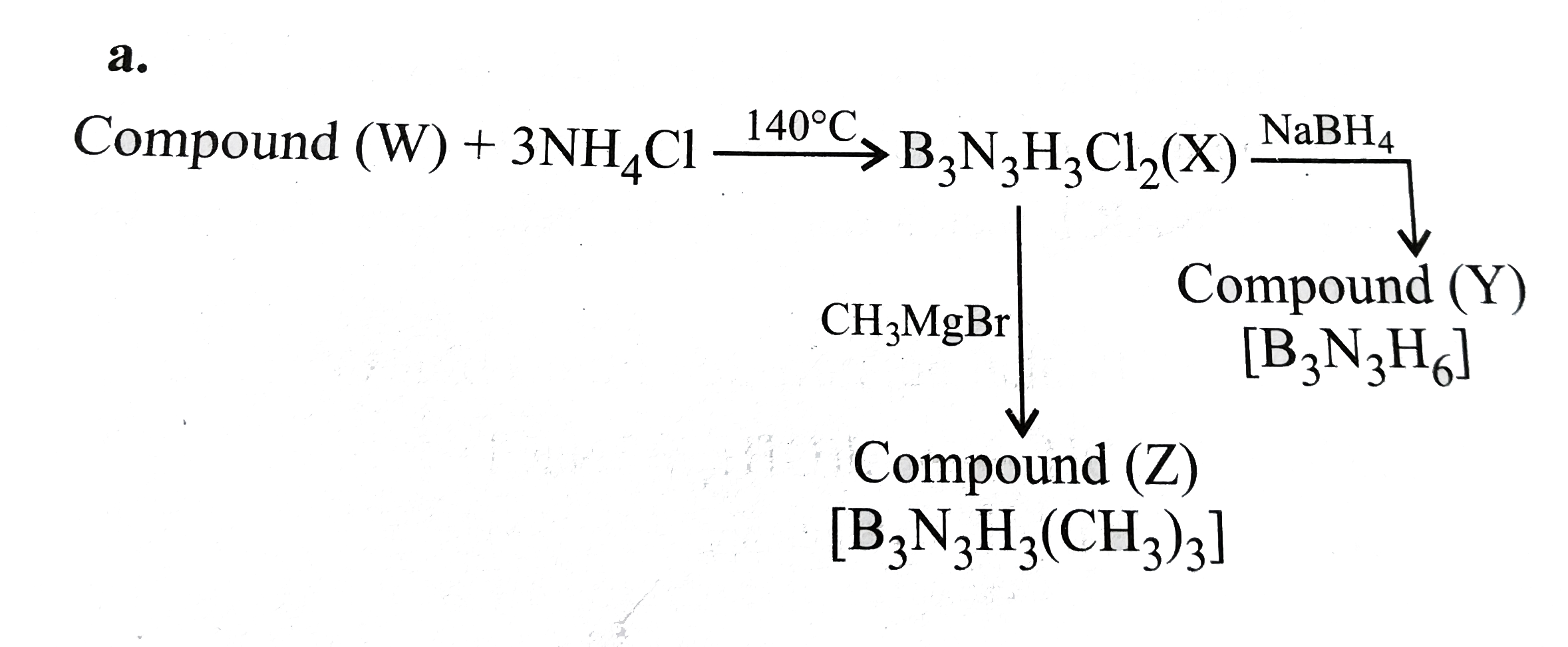Complete Solutions to Solved Examples of chapter P-BLOCK GROUP 13 - BORON FAMILY of Class 11 book with complete answers and questions
| Class 11 | CHEMISTRY |
| Chapter | P-BLOCK GROUP 13 - BORON FAMILY |
| CENGAGE CHEMISTRY | Solved Examples |
| Number Of Questions | 16 |
| Academic Year | 2023-24 |
When an inorganic compund X having `3c-2e^(-)` as well as `2c^(-1)-2e^(-1)` bonds react with `NH_(3)` gas at a certain temperature, gives a compound Y, isostuctural with benzene. Compound X with ammonia at a hight temperature produces a substance Z, then
View SolutionBoric acid on heating at `100^@ C`, gives `(X)`. `(X)` on heating at `160^@ C` gives `(Y)` and `(Y)` on heating at red hot gives `(Z)`. Identify `(X),(Y)` and `(Z)`.
View SolutionAmorphous boron is extracted from borax by the following steps :
`"Borax" overset((A))rarr H_(3) BO_(3) overset("Heat")rarr B_(2) O_(3) overset((B)) rarr "Boron" (A) and (B) are`
(a) `H_(2) SO_(4), Al`
(b) `HCl`, Carbon
( c) `H_(2) SO_(4), Mg`
(d) `HCl, Fe`.
View SolutionA certain salt `(X)` gives the following tests :
(a) Its aqueous solution is alkaline to litmus.
(b) On strong heating, it swells up to give a glassy material `(Y)`.
(c) When conc. `H_(2) SO_(4)` is added to a hot concentrated solution of `(X)`, white crystal of a weak acid `(Z)` separates out.
Identify `(X), (Y) and (Z)` and write down the chemical equations for reaction at steps `a, b` and `c`.
View SolutionA white crystalline compound `(X)` swells open heating and gives violet-coloured flame. Its aqueous solution gives the following reactions :
(a) A white precipitate is formed, with `BaCl_(2)` in presence of `HCl`.
(b) When treated with excess of `NH_(4) OH`, it gives white gelatinous precipitate. the white precipitate dissolves in `NaOH` and reappears on boiling with concentrated solution of `NH_(4) Cl`.
( c) It gives yellow precipitate with cobaltinitrite solution. Identify `(X)` and explain the reaction at steps `a, b` and `c`.
View SolutionThe metallic salt `(XY)` is soluble in water.
(a) When the aqueous soluble of `(XY)` is treated with `NaOH` solution, a white precipitate `(A)` is formed. In excess of `NaOH` solution, a white precipitate `(A)` is formed. In excess of `NaOH` solution, white precipitate `(A)` dissolves to form a compound `(B)`. When this solution is boiled with soild `NH_(4) Cl`, a precipitate of compound `(C)` is formed.
(b) An aqueous solution on treatment with `BaCl_(2)` solution gives a white precipitate `(D)` white is insoluble in conc `HCl`.
( c) The metallic salt `(XY)` forms a double salt `(E)` with potassium sulphate.
Identify `(XY),(A),(B),(C),(D)` and `(E)`.
View SolutionAn inorganic compound 'A' shows the following reactions:
(i) It is white solid, exists as dimer and fumes in wet air.
(ii) It sublimes at `180 .^(@)C` and forms monomer if heated of `400 .^(@)C`
(iii) Its aqueous solution turns litmus to red and gives a white precipitate with `AgNO_(3)` solution, which is soluble in `NH_(4)OH`
(iv) Addition of `NH_(4)OH` and `NaOH` separately to the solution of 'A' gives a gelatinous precipitate which in however soluble in excess of NaOH
The compound A is
View SolutionCompound (X) on reduction with `LiAIH_(4)` gives a hydride (Y) containing 21.72% hydrogen along with other products. The compound (Y) reacts with air explosively resulting in boron trioxide. Compounds X and Y are repectively.
View SolutionAn inorganic Lewis acid `(X)` shows the following reactions :
(a) It fumes in moist air.
(b) The intensity of fumes increase when a rod dippod in `NH_(4) OH` is brought near it.
( c) To an aqueous solution of `(X)`, addition of `NH_(4)Cl` and `NH_(4)OH` gives a precipitate which dissolves in `NaOH` solution.
(d) An acidic solution of `(X)` does not give a precipitate with `H_(2) S`.
Identify `(X)` and gives chemical reactions for `(a)` to `(d)`.
View Solution(a) On bolining a minerak `(A)` with `NaCO_(3)` solution, a white precipirtate `(B)` is formed.
(b) The precipitate is fitered and the filtrate contains two conpounds `( C)` and `(D)`. The componds `( C)` is removed by crystallisation and when `CO_(2)` is passed through the mother liquor left, `(D)` changes to `( C)`.
( c) On strongly heating `( C)`, two compounds `(D)` and `( E)` are formed.
(d) `(E)` on heating with cobalt oxide provides blue-coloured substance `(F)`.
Identify `(A)` to `(F)` and give chemical reaction for `(a)` to `(d)`.
View SolutionIn the following reactions sequence,
`(A) + N_(2) overset(Delta)(to) (B) overset(+H_(2)O)(to) (C ) + (D)`
White ppt. (C ) is formed and gas (D) is evolved. White ppt. (C ) dissolves in NaOH solution, while gas (D) gives white fumes in HCI. Thus, (A) is
View SolutionA colourless mixture of two salts `(A)` and `(B)` (excess) is soluble in `H_(2) O. (A)` turns blue litmus red and `(B)` turns red litmus blue. `(A)` gives white precipitate with `(B)`, which dissolves in excess of `(B)` forming `( C).(A)` when placed in atmosphere gives fumes and can form dimer. `(A)` gives white precipitate with `NH_(4) Cl` and `NH_(4)OH` which is soluble in `(B)`. Identify `(A), (B)` and `(C)`. Explain reactions.
View Solution`B_(10)C_(2)H_(12)` is isoelectronic with
View SolutionDraw possible structures of `B_(4)H_(10)` and `B_(5) H_(11)` molecules, showing the existence of `(3c, 2e)` bridge bonds.
View SolutionHow many the electrical conductivity of `Al_(2)Cl_(6)` changes on heating ?
View SolutionComplete the following :

View Solution
Solved Examples questions and complete solutions for chapter P-BLOCK GROUP 13 - BORON FAMILY of CENGAGE CHEMISTRY (ENGLISH) of Class 11
All Exercises from CENGAGE CHEMISTRY Class 11 CHEMISTRY P-BLOCK GROUP 13 - BORON FAMILY
- Ex 6.1 (Objective)
- Ex 6.1 (Subjective)
- Exercise (Assertion-Reasoning)
- Exercise (Fill In The Blanks)
- Exercise (Integer)
- Exercise (Linked Comprehension)
- Exercise (Multiple Correct)
- Exercise (Single Correct)
- Exercise (True/False)
- Exercise Archives (Assertion-Reasoning)
- Exercise Archives (Fill In The Blanks)
- Exercise Archives (Integer)
- Exercise Archives (Multiple Correct)
- Exercise Archives (Singlecorrect)
- Exercise Archives (Subjecive)
- Exercise Archives (True/False)
- Illustration
- Solved Examples